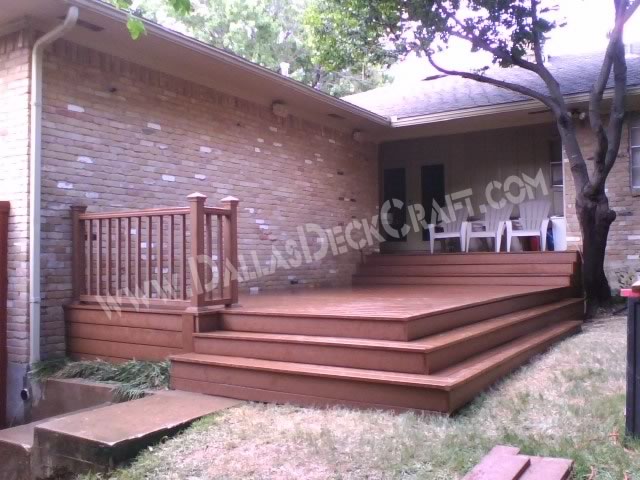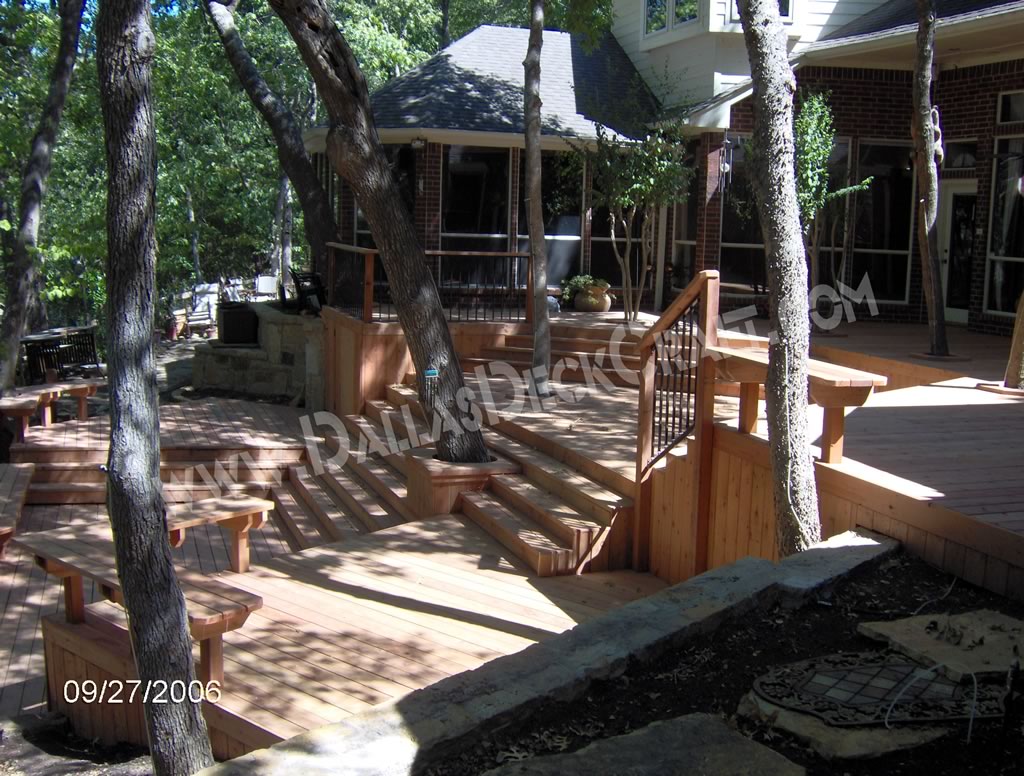Tag Archives for " outdoor decks "

Exploring the Benefits of Ipe and Red Balau Wood Decking
Red Balau Decking or Ipe?
More and more homeowners are choosing to have their outdoor decks constructed with exotic, tropical, imported woods. This isn’t just a stylistic choice either—in many cases, these woods offer a lot of functional benefits in addition to a unique, aesthetically appealing look.
Two such woods are ipe and red balau. Let’s explore each wood and discuss why you might want to use one or the other for your outdoor wood deck.
What is Ipe Wood, and Why is it Good for a Deck?
Ipe (pronounced “Ee-pay”) has become quite popular in the past ten or so years, and for good reason. It’s a tropical hardwood from the rainforests of Brazil, and ipe decks have garnered so much attention stateside as a result of its beautiful appearance and extreme functionality.
The wood is very, very dense, and therefore it can last much longer than standard wood types when properly treated.
To give you an idea of how incredibly hard ipe wood decking is, the pieces will often come pre-grooved for hidden fasteners before your contractor installs the deck. While technically an exaggeration, the wood has often been compared to steel and called ironwood.
There are some other benefits of having an ipe deck to consider as well:
- Ipe is generally considered to be environmentally friendly wood; it’s 100% natural and not a composite.
- Surface scratches are rare and fairly difficult to inflict.
- Have we made it clear how hard this wood is yet? The density doesn’t just mean ipe lasts a long time but it’s also resistant to mold, wood burrowing pests, weather damage, and even fire to a certain extent. (You would have a hard time building a campfire with ipe.) It also meets or exceeds fire ratings on many occasions.
What is Red Balau Wood, and Why is it Good for a Deck?
Red balau, comes from the tropical rainforests in Malaysia and is another very dense wood that’s become popular in recent years due to its extreme durability and attractive price.
Red balau is often compared to teak with the exception that balau is much cheaper and much more durable. Balau is often used in projects which require wood to be resistant to water, like bridges or watercraft ramps and boat docks.
Since red balau is a naturally oily wood, it must be properly sealed with oil, otherwise it can dry out and/or absorb spills quite easily. Modern sealants do a good job of protecting the wood but when the wood density it needs to be reapplied often. Red balau decking construction is a great option for homeowners looking to extend their living to the outdoors.
Also like ipe, properly sealed balau is highly resistant to scratching and scuffing. The density of the wood also helps prevent infestations from wood pests, weather damage, and mold.
Decking made of balau also offers homeowners a considerable range of appearance options, as the color of the wood can range from a pale off white to a dark brown, depending on species. The grain is generally coarse and beautiful when finished.
Other Considerations About Ipe and Red Balau
Even though ipe and red balau woods are both imported and shipped in from Brazil and Southeast Asia, respectively these woods are surprisingly affordable. Homeowners looking to improve the value of their property with an affordable investment should be aware that installing an outdoor wood deck is one of the most cost effective ways of raising a home’s value, not to mention it provides an added extension to the outdoors.
High density woods are becoming more popular for their longevity, strength, and comparatively low-maintenance needs. Replacing properly treated ipe or balau as a result of pests or weather damage is practically unheard of.
Whether you decide to go with ipe or balau for your outdoor decking project is largely a matter of preference and current wood pricing. Either of these fine imported tropical woods will serve as an excellent long-term investment into the value of your home.

A Brief Overview of the Benefits of Composite Decking
In the past decade or so, advancements have significantly improved the quality of composite decking, yielding a material that is stronger, longer-lasting, and less prone to warping, deterioration, and other common problems associated with outdoor wooden construction.
How is Composite Decking Made?
Composite decking is generally made from the combination of wood and plastic (hence composite). The wood is usually sourced from lumber byproducts such as wood chips, fibers, and sawdust. The plastics used are often recycled polyethylenes (but not always—you’ll have to confirm with the product manufacturer).
Producers of composite decking take the wood and the plastic products and heat them up, at which point coloring and a preservative agent are added to the “wood soup.” Finally, the mixture is poured into casts to form boards. Once it hardens, the composite decking is ready to be shipped to your local supplier.
The Best Uses for Composite Decking
Composite decking has become a popular choice for outdoor decks as a result of its durability and resistance to weathering. Composite woods are also more resistant to moisture, making them a great choice for humid areas or as decking for above ground pools.
There are two kinds of composite decking: hollow and solid. Hollow decking isn’t as popular as solid decking, as it tends to look less realistic and isn’t as sturdy as its counterpart, but it does carry the benefit of being less prone to temperature and moisture related expansion and contraction.
Solid composite decking can contract and expand more, but is generally more durable and strong. Which type you choose is largely dependent upon the intended use of the deck and the temperature conditions where you live.
The aesthetic appeal of composite wood has also substantially improved over the years—while a trained eye might still be able to spot it, as it’s not a perfect 1:1 replica of “real” wood, composite wood can often look very natural and pleasing.
A wide variety of grains, colors, and other options are available to homeowners—matching composite wood to the already-existing wood in your home is generally a fairly easy process.
Most composite decking comes with a fairly long warranty—as this material is designed to last quite a long time—but homeowners should be aware that in order to take advantage of the warranty, the deck has to be built according to the manufacturers directions.
Hiring a professional deck builder ensures that your warranty will be valid for years to come.
Composite wood can also be used for parts of your outdoor deck other than the deck itself; for example, suppose you had your deck built out of Trex composite decking. Trex also makes railing out of composite wood, meaning that your entire project can remain uniform.
As a final note, composite decking does require maintenance, though this maintenance is generally considered a bit less intensive than natural wood requires. Typically, composite decking must be cleaned at least once per year.
Composite Decking Prices
In addition to its improvements over the past few years, the cost of composite decking has also become much more affordable.
However, a common misconception is that composite decking is significantly cheaper than “real” wood—while this can be true, it isn’t always the case. Just like natural woods, the price of composite decking will vary based on quality and type.
Whether you decide to build your deck using composite decking or natural wood decking, you can expect to find prices similar to each other which offer different benefits—therefore, the smart move will be to base your purchase on the intended use of the deck (e.g., an above ground pool deck may benefit from composite wood’s resistance to moisture).

How Installing the Right Deck Can Make Your Home Feel Twice as Big
Outdoor Decks Expand Your Living Space
Maybe you have found yourself wishing that your home was just a little bit bigger? There are a lot of advantages to having more space in your home. The extra room can be more accommodating to your guests, serve as a new place to spend time with your family, or it can simply give you a great place for reading a book and relaxing.
But adding on a new room to your house can often invite more trouble than it’s worth. For one, it can easily approach the realm of being cost prohibitive. The addition of a room can take time, and during that time you’ll have construction workers, dust, messes and noise to contend with.
These are just a few of the many reasons why so many homeowners opt to have an outdoor deck installed onto their home – it’s considerably cheaper, faster, and generally results in a lot more usable space than a single room can offer.
A Deck Can be More Than Just an Extension to the Outdoors
To hire a deck builder for construction of a patio deck on your home provides you with more than just a simple extension to the outdoors, although for most of us that’s the main selling point. There’s nothing quite as enjoyable as getting some fresh air while checking your email on your laptop or phone.
A deck gives you a lot of new ways you can use your home:
- You have a new place for outdoor dinner parties during the warm months.
- A deck can serve as a place for outdoor crafts.
- The perfect location for your new grill.
- Your deck could quickly become an “outdoor living room.”
Installing a Deck is One of the Most Cost Effective Ways to Raise the Value of Your Home
It’s pretty rare for a homeowner to see an improvement pay for itself by the time they sell their home, but outdoor decking has long been one of the most cost effective ways a homeowner can raise the value of his or her home without breaking their wallets or taking an inordinate amount of time to do it, as deck builders are generally very affordable to hire.
In 2007, Remodeling Magazine had a feature called “Remodeling Cost vs. Value Report for 2007.” It sounds a bit dry, but perk up your ears if you’re considering installing a deck on your home as the article showed that in most cases over 85% of the cost of installing an outdoor deck was recouped by homeowners when they decided to sell their house.
This is quite an improvement over, say, bathroom remodeling (78% recouped) or the comparatively low 69% return seen on room additions. If you’re looking for a way to raise the value of your home, a deck is one of the smartest options at your disposal.
Deck Maintenance is Easier Than You Think
One of the primary concerns for homeowners considering installing a deck on their home is, fortunately, one that can be assuaged relatively easily as outdoor decks don’t require an intensive amount of maintenance and in most cases and homeowners can usually handle things on their own.
If you have a wooden deck installed, the biggest maintenance activity you’d have to undertake is ensuring that the deck doesn’t go neglected for years at a time—generally, this means nothing more difficult than cleaning the deck and reapplying a wood sealant to protect against weathering.
A homeowner might begin deck maintenance by clearing away any plants, furniture, or other items from the deck before giving it a good power wash (power washing units can be rented quite cheaply).
After the deck has been washed, a sealant is applied. Most of these sealants are designed to be safe and environmentally friendly.
For most homeowners, this is a process which demands no more than a single afternoon once every one or two years.
